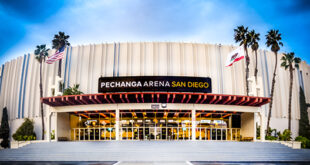The sales tax doesn’t always stay in the local community, but cities still go to great lengths to land, or keep, a dealership. San Bernardino is a prime example.
Three years ago, during the height of the recession, owners of the automobile dealerships at the San Bernardino Auto Center decided to fight back against the bad economy.
With sales down and the auto center down to three dealerships, the owners decided to form a property-based business-improvement district.
That program, better known as PBID, was started by the state of California in 1990. It allows business owners in a specific market to agree on a course of action to improve their business climate. Those improvements would be paid for with revenue from a special property tax assessment.
In the case of the auto center, the dealership owners agreed on two things: they had to improve their marketing immediately, and the way to do that was to replace the reader board on Interstate 215 that advertised the auto center.
The reader board, which was installed for about $475,000 in the early 1990s, would cost $1.1 million to replace, said Colin Strange, director of business services for the San Bernardino Area Chamber of Commerce.
“It was outdated,” said Strange, who at the time was the manager of San Bernardino’s Office of Business Development. “It was so old it was almost embarrassing. I don’t think they had a hard time deciding they needed a new one.”
There was a problem, however. The auto center had lost several dealerships, and it needed to turn things around quickly or risk going out of business. Replacing the reader board with revenue from the special property tax would take too long.
That’s when the San Bernardino County Economic Development Agency stepped into the picture. It agreed to loan the improvement district the $1.1 million it would need to replace its dilapidated reader board.
San Bernardino also agreed to return, temporarily, some of its sale tax revenue to the auto center until the business got back on its feet. Ultimately, the city would be reimbursed from revenue from the temporary property tax.
Strange called that arrangement “unusual,” but said there was little disagreement among San Bernardino officials about whether the city should, in effect, loan the auto center $1.1 million to help it stay afloat.
That the city council agreed to such a move shows how important auto dealerships are to some cities, Strange said.
“It was the city saying to the auto center ‘we appreciate your performance and what you do for San Bernardino’,” Strange said. “We knew we had to help them, and that was the best way to do it.”
The auto center today – Toyota, Scion, Subaru, Kia, Mitsubishi, Nissan and a Volkswagen dealership that opened last month – generates an estimated $150 million in sales annually, making it one of San Bernardino’s largest sales tax producers.
San Bernardino’s 10 automobile dealerships might account for as much as 30 percent of San Bernardino’s yearly sales tax revenue, according to Strange.
“We would look pathetic if we didn’t have some auto dealerships,” said Judy Penman, chamber president and chief executive officer. “I compare them to malls. Cities go after automobile dealerships and malls because they both bring sales tax revenue. It would have been a disaster if we had lost the auto center.”
Whether the new reader board helped keep the auto center afloat is debatable, but it didn’t hurt. Two weeks before the Volkswagen dealership opened, Cliff Cummings, began expanding Toyota of San Bernardino, which he owns along with the Scion, Subaru and Mitsubishi dealerships.
As much of the San Bernardino business community watched, a wrecking ball crashed into the building that was once Shaver Chrysler. That space is being converted into a parking lot and a display room for the Toyota dealership, which Cummings has owned since 1997.
Cummings also plans to expand the Toyota sales and service department and add a second floor to the dealership’s administration building. His goal is to make the facility more “green” and look more modern.
He estimates that the renovation, which is expected to be finished in 2016, will cost about $10 million. His San Bernardino dealerships should sell about 5,000 cars in 2014, up from approximately 4,500 sold this year, Cummings said.
“I know how important we are to the city’s economy because I hear about it all of the time,” said Cummings, who opened a Toyota dealership in Indio the same day as the demolition ceremony in San Bernardino. “Someone is always reminding me of it. Auto dealerships are phenomenal in terms of helping a city’s economy.”
They also have a huge impact on the country’s economy.
The automobile industry – the single largest manufacturing sector in the United States – generated at least $91.5 billion in state government tax revenues in 2010, which was 13 percent of all state government tax revenues collected nationwide that year, according to a study by the Center for Automotive Research, a non-profit agency in Ann Arbor, Mich.
Of that, $30 billion came from taxes on the sale of new and used automobiles, including more than $3.5 billion generated in California. according to the study, which the CAR conducted for the Alliance of Automobile Manufacturers in Washington, D.C.
Historically, new and used automobile sales have accounted for up to 25 percent of the sales revenue in the Inland Empire, said Jordan Levine, economist and director of economic research with Beacon Economics in Los Angeles.
However, that doesn’t necessarily mean the tax revenue stays local. In California, tax revenue from an automobile sale goes to the city in which the car is registered, not to the city where it’s sold.
“A lot of people don’t understand that, but it’s true,” Levine said. “But that doesn’t change the fact that automobile sales are a huge part of the economy. In the Inland Empire they’re second only to business-to-industry sales.”
Not every city, however, can share in those profits. Rancho Cucamonga has Victoria Gardens, one of the premiere regional shopping malls in Southern California, but it doesn’t have a car dealership and is not likely ever to get one, said Linda Daniels, the city’s assistant city manager.
Ontario, Montclair and Upland all have multiple auto dealerships, and the auto companies don’t like to put their dealerships to close to each other, Daniels said.
“We almost got one where Victoria Gardens is located, but that didn’t happen,” Daniels said. “It’s a little frustrating because we would like to have one, but unless someone closes down I don’t see how we can get one.”
 IE Business Daily Business news for the Inland Empire.
IE Business Daily Business news for the Inland Empire.


